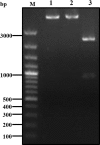Cloning, expression and activity of ATP-binding protein in Bacillus thuringiensis toxicity modulation against Aedes aegypti
- PMID: 31238963
- PMCID: PMC6593554
- DOI: 10.1186/s13071-019-3560-2
Cloning, expression and activity of ATP-binding protein in Bacillus thuringiensis toxicity modulation against Aedes aegypti
Abstract
Background: Bacillus thuringiensis israelensis (Bti) is a widely used mosquitocidal microbial pesticide due to its high toxicity. ATP-binding proteins (ABP) are prevalently detected in insects and are related to reaction against Bti toxins. However, the function of ABP in mosquito biocontrol is little known, especially in Aedes aegypti. Therefore, this study aimed to clarify the function of ABP in Ae. aegypti against Bti toxin.
Results: Aedes aegypti ABP (GenBank: XM_001661856.2) was cloned, expressed and purified in this study. Far-western blotting and ELISA were also carried out to confirm the interaction between ABP and Cry11Aa. A bioassay of Cry11Aa was performed both in the presence and absence of ABP, which showed that the mortality of Ae. aegypti is increased with an increase in ABP.
Conclusions: Our results suggest that ABP in Ae. aegypti can modulate the toxicity of Cry11Aa toxin to mosquitoes by binding to Bti toxin. This could not only enrich the mechanism of Bt toxin, but also provide more data for the biocontrol of this transmission vector.
Keywords: ATP-binding protein; Aedes aegypti; Biocontrol; Bti; Interaction.
Conflict of interest statement
The authors declare that they have no competing interests.
Figures







Similar articles
-
Aedes aegypti Galectin Competes with Cry11Aa for Binding to ALP1 To Modulate Cry Toxicity.J Agric Food Chem. 2018 Dec 26;66(51):13435-13443. doi: 10.1021/acs.jafc.8b04665. Epub 2018 Dec 17. J Agric Food Chem. 2018. PMID: 30556692
-
Long-term exposure of Aedes aegypti to Bacillus thuringiensis svar. israelensis did not involve altered susceptibility to this microbial larvicide or to other control agents.Parasit Vectors. 2018 Dec 29;11(1):673. doi: 10.1186/s13071-018-3246-1. Parasit Vectors. 2018. PMID: 30594214 Free PMC article.
-
Functional characterization of Aedes aegypti alkaline phosphatase ALP1 involved in the toxicity of Cry toxins from Bacillus thuringiensis subsp. israelensis and jegathesan.Peptides. 2017 Dec;98:78-85. doi: 10.1016/j.peptides.2017.05.011. Epub 2017 Jun 3. Peptides. 2017. PMID: 28587836 Free PMC article.
-
Role of Lectin in the Response of Aedes aegypti Against Bt Toxin.Front Immunol. 2022 May 13;13:898198. doi: 10.3389/fimmu.2022.898198. eCollection 2022. Front Immunol. 2022. PMID: 35634312 Free PMC article. Review.
-
[Transgenic bioinsecticides inimical to parasites, but imical to environment].Wiad Parazytol. 2003;49(1):11-20. Wiad Parazytol. 2003. PMID: 16889013 Review. Polish.
Cited by
-
Bacterial Toxins Active against Mosquitoes: Mode of Action and Resistance.Toxins (Basel). 2021 Jul 27;13(8):523. doi: 10.3390/toxins13080523. Toxins (Basel). 2021. PMID: 34437394 Free PMC article. Review.
-
Environmental Behaviors of Bacillus thuringiensis (Bt) Insecticidal Proteins and Their Effects on Microbial Ecology.Plants (Basel). 2022 Apr 29;11(9):1212. doi: 10.3390/plants11091212. Plants (Basel). 2022. PMID: 35567212 Free PMC article. Review.
-
Involvement of an Enhanced Immunity Mechanism in the Resistance to Bacillus thuringiensis in Lepidopteran Pests.Insects. 2023 Feb 1;14(2):151. doi: 10.3390/insects14020151. Insects. 2023. PMID: 36835720 Free PMC article. Review.
References
MeSH terms
Substances
Grants and funding
LinkOut - more resources
Full Text Sources

